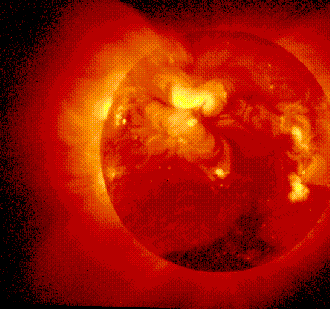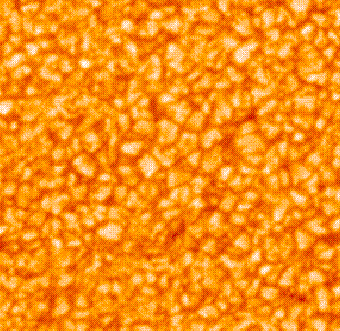(1) University of Colorado, Boulder, CO.
(2) Lockheed Palo Alto Research Laboratories, Palo Alto, CA.
Click here for a NSF GAFD research highlight . or for a NSF HPCC project overview .
 What we are ultimately interested in is our nearest star the Sun. The
Sun is a convenient star since it is located a mere 93.5 million miles
away (on average) and so it is relatively easy to observe.
Looking from a great distance, the Sun shows many large scale features,
reflected in enhanced emission by magnetic fields,
as shown here (right) in a soft X-ray (SXT) image from the Yohkoh satellite
(images here courtesy of Lockheed Palo Alto Research Labs). These
features are on the scale of a significant fraction of the solar surface
and the magnetic fields which drive such phenomena exhibit a long term
cyclic behaviour with a period of 22 years.
What we are ultimately interested in is our nearest star the Sun. The
Sun is a convenient star since it is located a mere 93.5 million miles
away (on average) and so it is relatively easy to observe.
Looking from a great distance, the Sun shows many large scale features,
reflected in enhanced emission by magnetic fields,
as shown here (right) in a soft X-ray (SXT) image from the Yohkoh satellite
(images here courtesy of Lockheed Palo Alto Research Labs). These
features are on the scale of a significant fraction of the solar surface
and the magnetic fields which drive such phenomena exhibit a long term
cyclic behaviour with a period of 22 years.
If you looked much closer at the surface, e.g. in the intensity of various emission lines as taken from a telescope in La Palma (below), the Sun looks very different, showing very small-scale turbulent motions known as solar granulation. These motions overturn in 10 minutes and are roughly 5000km across.

These phenomena are driven by thermal convection which operates in the outer 1/3 of the Sun in order to try and get the energy from the inner nuclear-burning core to the radiative surface as efficiently as possible. The major problem is how can such small-scale turbulence and such large-scale order co-exist?
Of course, the Sun is a very complicated beast and we cannot hope to get all the miniscule details right, so we go to vastly simplified models and study the physics of compressible convection. The driving forces and fluid properties of the solar gases are such that the motions are almost certainly turbulent and hence we require large supercomputers to be able to model a situation pertaining to the real object.
Click here to carry on with a tour of the models we use and then the scientific results.
Otherwise, there is an fairly concise and comprehensive abstract of what we try to do. A slightly longer and more complete description of the project exists too. There is also a bunch of papers available for your perusal. On the other hand, you could go straight to the pretty pictures in the picture gallery , or you could actually watch some movies from the animation gallery.